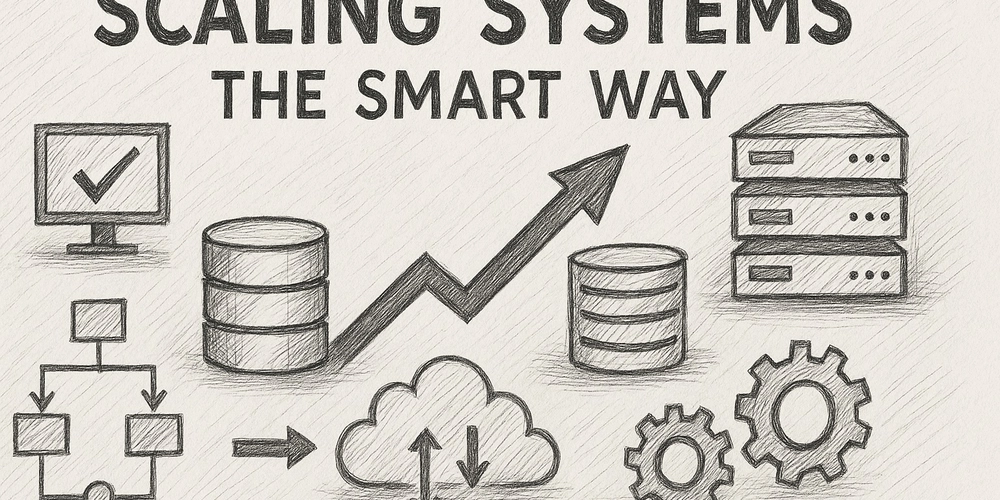Scaling Systems the Smart Way: A Pragmatic Guide for Devs
In today’s software world, building a feature is the easy part. What separates an amateur project from a production-ready system is how well it scales. Whether you're running a SaaS app with thousands of users, an internal tool for a growing company, or a hobby project that might blow up overnight — scalability is the difference between survival and collapse. 1. Start with Simplicity "Premature optimization is the root of all evil." – Donald Knuth Don't immediately build infrastructure for millions of users when you're just starting with a handful. The temptation to over-engineer early is strong, but resist it. Instead, focus your energy on writing clean, maintainable code with a clear structure that others can understand and modify. Begin with a straightforward single-node setup that meets your current needs. Using a local SQLite database for development? That's perfectly acceptable. Storing some data in JSON files while you validate your approach? That works too. The key is to architect your system in a way that components can be swapped out later when you need more scalability. Keep your initial implementation simple, but ensure your code structure allows for future evolution without requiring a complete rewrite. 2. Separate Compute from Storage Avoid performance bottlenecks by implementing a clear separation between your application logic and data storage layers. This fundamental architectural principle ensures that each component can scale independently as needed. When designing your system, leverage specialized storage solutions for different types of data: utilize object storage services (such as Amazon S3 or Google Cloud Storage) for handling static assets and large files, employ managed database services for maintaining application state and structured data, and deploy containers for running your computation workloads. This separation allows you to optimize each layer independently and makes it easier to scale individual components as demand grows. As a best practice, avoid architectures where your compute resources are directly dependent on local disk I/O operations, as this creates tight coupling that can limit your scaling options and potentially impact system performance. 3. Design for Horizontal Scaling Vertical scaling, which involves upgrading to more powerful servers with additional CPU cores, memory, and storage capacity, can be an effective solution in the short term—but eventually reaches physical and financial limitations. Instead, embrace horizontal scaling strategies by leveraging modern cloud-native technologies. Deploy your applications using containerization technologies, implement serverless functions for event-driven workloads, and design stateless APIs that can be easily replicated across multiple instances. This distributed approach to handling traffic ensures better resource utilization and improved system reliability. Contemporary orchestration platforms like Kubernetes simplify container management at scale, while managed deployment platforms such as Vercel or Fly.io abstract away much of the operational complexity, making horizontal scaling more accessible to development teams. 4. Use Queues and Workers When your application needs to handle time-consuming operations or resource-intensive tasks, it's crucial to implement an efficient offloading strategy. Rather than processing these tasks synchronously and potentially blocking your main application thread, consider delegating them to background processes. Implement a robust message broker system (such as RabbitMQ for reliability, Redis for speed, or Amazon SQS for managed services) to handle task distribution and ensure message persistence Deploy dedicated worker processes that can independently handle asynchronous jobs, allowing your main application to remain responsiveBy implementing this architecture, you'll significantly enhance both the user experience by eliminating wait times and system reliability by preventing resource exhaustion. Additionally, this approach provides better scalability as you can easily add more workers to handle increased workloads. 5. Monitor, Then Optimize Leverage comprehensive observability tools and platforms (such as Grafana for visualization, Datadog for infrastructure monitoring, New Relic for application performance, or even carefully structured application logs) to systematically identify and analyze performance bottlenecks in your system. Implement detailed metrics collection and monitoring dashboards to track key performance indicators across your infrastructure. Only invest time and resources in optimizing components that demonstrate measurable performance issues and directly impact the end user's experience or business objectives. 6. Cache Aggressively Consider caching any data that remains relatively static over time. By intelligently implementing caching strategies, you can dramatically reduce database load and improve response times for your users. The key is id

In today’s software world, building a feature is the easy part. What separates an amateur project from a production-ready system is how well it scales.
Whether you're running a SaaS app with thousands of users, an internal tool for a growing company, or a hobby project that might blow up overnight — scalability is the difference between survival and collapse.
1. Start with Simplicity
"Premature optimization is the root of all evil." – Donald Knuth
Don't immediately build infrastructure for millions of users when you're just starting with a handful. The temptation to over-engineer early is strong, but resist it. Instead, focus your energy on writing clean, maintainable code with a clear structure that others can understand and modify. Begin with a straightforward single-node setup that meets your current needs. Using a local SQLite database for development? That's perfectly acceptable. Storing some data in JSON files while you validate your approach? That works too. The key is to architect your system in a way that components can be swapped out later when you need more scalability. Keep your initial implementation simple, but ensure your code structure allows for future evolution without requiring a complete rewrite.
2. Separate Compute from Storage
Avoid performance bottlenecks by implementing a clear separation between your application logic and data storage layers. This fundamental architectural principle ensures that each component can scale independently as needed. When designing your system, leverage specialized storage solutions for different types of data: utilize object storage services (such as Amazon S3 or Google Cloud Storage) for handling static assets and large files, employ managed database services for maintaining application state and structured data, and deploy containers for running your computation workloads. This separation allows you to optimize each layer independently and makes it easier to scale individual components as demand grows. As a best practice, avoid architectures where your compute resources are directly dependent on local disk I/O operations, as this creates tight coupling that can limit your scaling options and potentially impact system performance.
3. Design for Horizontal Scaling
Vertical scaling, which involves upgrading to more powerful servers with additional CPU cores, memory, and storage capacity, can be an effective solution in the short term—but eventually reaches physical and financial limitations. Instead, embrace horizontal scaling strategies by leveraging modern cloud-native technologies. Deploy your applications using containerization technologies, implement serverless functions for event-driven workloads, and design stateless APIs that can be easily replicated across multiple instances. This distributed approach to handling traffic ensures better resource utilization and improved system reliability. Contemporary orchestration platforms like Kubernetes simplify container management at scale, while managed deployment platforms such as Vercel or Fly.io abstract away much of the operational complexity, making horizontal scaling more accessible to development teams.
4. Use Queues and Workers
When your application needs to handle time-consuming operations or resource-intensive tasks, it's crucial to implement an efficient offloading strategy. Rather than processing these tasks synchronously and potentially blocking your main application thread, consider delegating them to background processes.
- Implement a robust message broker system (such as RabbitMQ for reliability, Redis for speed, or Amazon SQS for managed services) to handle task distribution and ensure message persistence
- Deploy dedicated worker processes that can independently handle asynchronous jobs, allowing your main application to remain responsiveBy implementing this architecture, you'll significantly enhance both the user experience by eliminating wait times and system reliability by preventing resource exhaustion. Additionally, this approach provides better scalability as you can easily add more workers to handle increased workloads.
5. Monitor, Then Optimize
Leverage comprehensive observability tools and platforms (such as Grafana for visualization, Datadog for infrastructure monitoring, New Relic for application performance, or even carefully structured application logs) to systematically identify and analyze performance bottlenecks in your system. Implement detailed metrics collection and monitoring dashboards to track key performance indicators across your infrastructure. Only invest time and resources in optimizing components that demonstrate measurable performance issues and directly impact the end user's experience or business objectives.
6. Cache Aggressively
Consider caching any data that remains relatively static over time. By intelligently implementing caching strategies, you can dramatically reduce database load and improve response times for your users. The key is identifying which data elements change infrequently enough to benefit from caching without risking stale content.
- Implement Redis or other in-memory stores for fast-access caching of frequently requested data, session information, and computed results that don't require immediate consistency
- Deploy content delivery networks (CDNs) strategically to cache and serve static assets, HTML pages, and other content from edge locations closest to your users, reducing latency and server load
- Configure HTTP caching headers thoughtfully to enable browser-side caching while maintaining appropriate cache invalidation controls - consider using ETag headers, Cache-Control directives, and conditional requests to optimize cache efficiency
7. Build Resilience In
Scalable systems must be designed with resilience in mind to gracefully handle failures, unexpected load spikes, and degraded service conditions. A truly resilient system maintains functionality even when individual components experience issues:
- Use retries with exponential backoff to handle transient failures, allowing systems to automatically recover from temporary disruptions while preventing cascading failures from overwhelming downstream services
- Add circuit breakers to protect system components by detecting when dependent services are failing or performing poorly, automatically stopping requests to prevent system overload, and allowing controlled recovery periods
- Gracefully handle partial failures by implementing fallback mechanisms, degraded service modes, and isolation strategies that prevent localized issues from cascading into system-wide outages
8. Plan for Data Growth
As your application grows, your database will inevitably expand in size and complexity. Planning for data growth from the beginning is essential to maintain performance and reliability at scale:
- Implement effective pagination and strategic indexing strategies to optimize query performance and manage large result sets efficiently while maintaining responsive user experiences
- Develop a comprehensive data archival strategy to systematically move older, less frequently accessed data to cost-effective storage solutions while keeping your primary database lean and performant
- When data volume exceeds single-server capacity, consider implementing database sharding or partitioning to distribute the load across multiple nodes while ensuring data consistency and availability
Final Thoughts
Scalability isn't just about handling millions of requests per second - it encompasses a holistic approach to system design that enables sustainable growth. It's about crafting robust architectures that can elegantly adapt and expand to meet increasing demands. Most importantly, it's about building systems that grow with your users, evolve alongside your team's capabilities, and scale in harmony with your organizational ambitions.
Build smart by laying strong foundations. Scale slow by making deliberate, measured improvements. Grow strong by maintaining system integrity throughout periods of expansion.
By Babak Nabiee – Founder, BNAB Consulting









































































































































































![[The AI Show Episode 146]: Rise of “AI-First” Companies, AI Job Disruption, GPT-4o Update Gets Rolled Back, How Big Consulting Firms Use AI, and Meta AI App](https://www.marketingaiinstitute.com/hubfs/ep%20146%20cover.png)

























































































































![[DEALS] The Premium Python Programming PCEP Certification Prep Bundle (67% off) & Other Deals Up To 98% Off – Offers End Soon!](https://www.javacodegeeks.com/wp-content/uploads/2012/12/jcg-logo.jpg)















































































































































_Aleksey_Funtap_Alamy.jpg?width=1280&auto=webp&quality=80&disable=upscale#)
_Sergey_Tarasov_Alamy.jpg?width=1280&auto=webp&quality=80&disable=upscale#)















































































































![Apple Developing New Chips for Smart Glasses, Macs, AI Servers [Report]](https://www.iclarified.com/images/news/97269/97269/97269-640.jpg)
![Apple Shares New Mother's Day Ad: 'A Gift for Mom' [Video]](https://www.iclarified.com/images/news/97267/97267/97267-640.jpg)
![Apple Shares Official Trailer for 'Stick' Starring Owen Wilson [Video]](https://www.iclarified.com/images/news/97264/97264/97264-640.jpg)



































































































